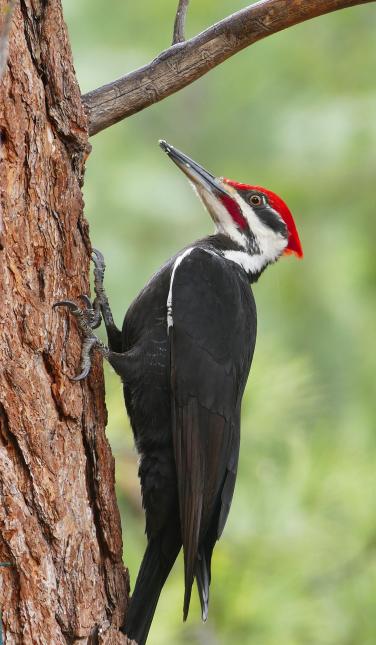Woodpeckers Unleashed: Checking Out the Wonders of These Knowledgeable Tree Climbers
Woodpeckers, with their distinct markings and balanced drumming echoing via wooded locations, hold an unique location in the bird world. Their specialized makeup and adaptations allow them to navigate upright surface areas with exceptional ability. However, their mastery of tree climbing is simply one element of their remarkable habits. As we delve into the intricate information of woodpeckers' nesting routines, feeding techniques, and the continuous preservation efforts to protect these exceptional birds, a much deeper admiration for their place in nature unravels.
Makeup and Adaptations
When checking out the makeup and adjustments of woodpeckers, one can observe exceptional attributes that allow these birds to flourish in their specialized eco-friendly particular niche. Woodpeckers are geared up with a suite of distinct physiological features that aid them in their woodpecking behavior. One of the most popular attributes is their solid, chisel-like beak, which is specialized for exploration into timber to reveal bugs or create nesting cavities. This beak is supported by strong neck muscles and an extremely established skull structure that serves as a shock absorber, enabling woodpeckers to repetitively eat trees without creating mind injury. Furthermore, woodpeckers have zygodactyl feet, with 2 toes facing forward and 2 facing backward, providing a company grasp on tree trunks while they look for food or drum for interaction.
Moreover, woodpeckers have an unique tongue structure that is long, barbed, and sticky, enabling them to remove bugs from crevices in timber. This specific adaptation allows woodpeckers to exploit a food source that is hard to reach to many various other bird varieties. On the whole, the makeup and adjustments of woodpeckers showcase the impressive transformative solutions that have actually allowed these birds to thrive in their arboreal environment.
Drumming Behavior
Having actually explored the makeup and adaptations of woodpeckers, the focus currently shifts to recognizing their drumming behavior, a distinct aspect of their communication and territorial displays. Drumming is a crucial form of interaction amongst woodpeckers, offering multiple objectives such as establishing areas, attracting mates, and signaling alarm system. Each woodpecker types has an unique drumming pattern that assists people recognize members of their own varieties and differentiate them from rivals or killers.
Woodpeckers produce drumming audios by rapidly pecking on resonant surface areas such as dead trees, energy poles, or even metal things, creating a series of balanced beats. The strength and speed of drumming can vary based upon the objective; as an example, a fast drumming series may symbolize aggression towards burglars, while a slower and softer drumming pattern can indicate courtship (Woodpeckers in Florida). Furthermore, woodpeckers might readjust the regularity and duration of their drumming to convey particular messages properly
Nesting Practices
Discovering the nesting habits of woodpeckers exposes interesting understandings right into their reproductive habits and environment selections. Woodpeckers are recognized for their unique nesting preferences, typically excavating cavities in trees to create protected areas for increasing their young. These cavities offer not just as a nesting site yet additionally as a secure haven from predators and severe climate.
Woodpeckers exhibit a high degree of integrity to their nesting sites, often going back to the very same location year after year. This behavior highlights the relevance of ideal habitat availability for their reproductive success. The selection of a nesting site is essential for woodpeckers, with factors such as tree species, elevation, and degeneration phase playing substantial duties in their decision-making procedure.
Remarkably, some woodpecker species are known to dig deep you can try this out into several cavities within their territory, giving themselves with different nesting choices. This technique may work as a kind their website of insurance coverage against potential risks or disturbances to their key nesting website.

Feeding Techniques
One of the most distinct feeding habits of woodpeckers is drumming, which includes fast pecking on trees to uncover bugs under the bark. Woodpeckers are likewise understood to excavate dental caries in trees to accessibility concealed insect larvae or sap. Some varieties, like the acorn woodpecker, shop nuts in specifically created openings called granaries.
Preservation Efforts
Amidst the elaborate feeding techniques showed by woodpeckers, the preservation efforts intended at securing these fascinating birds play an important role in maintaining their habitats and populations. Woodpeckers encounter various threats to their survival, including environment loss because of logging, climate change altering their ecological communities, and accidents with man-made frameworks such as buildings and automobiles - Woodpeckers in Florida. Conservationists are proactively working to resolve these difficulties and ensure the lasting well-being of woodpecker types

Education and public recognition campaigns are also essential elements of woodpecker conservation initiatives. By increasing awareness investigate this site concerning the value of these birds in maintaining healthy and balanced woodland communities, conservationists can gather support for habitat preservation campaigns and promote responsible land administration techniques. With collaborative efforts in between researchers, policymakers, and local neighborhoods, we can work together to safeguard a future where woodpeckers grow in their natural habitats.
Final Thought
